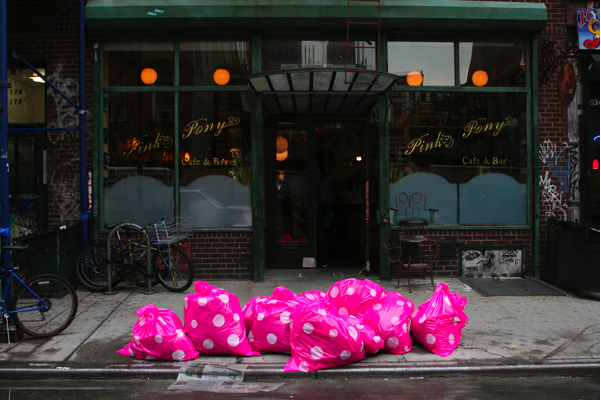
“Joy is an act of resistance.” It’s almost a platitude in the Trump era, visible across Instagram on embroidered banners and fine calligraphy, on t-shirts and tote bags. But what does this phrase really mean? Is joy actually a form of resistance to oppression, or is this phrase just a comforting balm to counter the guilt we feel when we find ourselves feeling good in a world that’s burning?
None of us want to be the rich people on the Titanic, sipping champagne in black tie while the water rises. But while there are good reasons to fear complacency, joy is fundamentally different than turning a blind eye. I’ve been thinking about these questions for a long time, and I believe there are at least six ways that joy can sustain activism. This week, with one year to go until the next U.S. presidential election, it seemed a good time to dig in and share a kind of blueprint for the intentional use of joy to foster change.
Joy is a propulsive force
It’s a curious feature of autocratic regimes that forms of joy are often banned. Music is a common one. In China under Mao, listening to the music of Beethoven was a crime. Folk or traditional music is typically condemned, such as in Nazi Germany, which targeted Jewish music. But contemporary hits are just as suspect; the Soviet Union, for example, censored songs by artists as varied as AC/DC, Tina Turner, and Julio Iglesias. In communist Albania, the regime of Enver Hoxha famously banned the saxophone. In Trinidad, the British banned drumming.
Dancing was similarly reviled, and all types of celebration found themselves in the crosshairs of European colonists setting out to spread Christianity and “civilization” around the world. Local authorities often forbade or disrupted native rites, or at minimum made relinquishing them a condition of conversion. Barbara Ehrenreich notes that in South Africa among the Namaquas, it was said that someone who converted to Christianity “had given up dancing.”
What dictators know is that joy has a propulsive force, and that anything that gathers and channels that energy threatens to upend the rigid control of a population. Music, dance, art, eroticism: all of these fuel an emotional response that creates momentum, one that can be hard to control. Take, for example, The Singing Revolution: a four-year series of protests involving mass singing demonstrations that swept across Latvia, Lithuania, and Estonia between 1987 and 1991, eventually leading to their independence.
Audre Lorde sums this idea up this clearly in her 1978 essay, The Uses of the Erotic, “In order to perpetuate itself, every oppression must corrupt or distort those various sources of power within the culture of the oppressed that can provide energy for change.” She goes on to point out that this has often been marshaled in patriarchal societies for the oppression of women. “For women, this has meant a suppression of the erotic as a considered source of power and information within our lives.” The denigration of feminine forms of joy, such as romance novels and films, fashion and home decor, is another manifestation of this insidious form of repression.
So, simply put, joy can be considered resistance because it’s a form of “energy for change,” as Lorde puts it. It counters and contrasts with the rigidity and control of oppressive structures in a non-violent way.
Joy creates unity
The power of celebrations goes beyond the energy they create. I began to realize this when I was studying animal celebrations. Only a few animal species celebrate, and the ones that do have two things in common with humans: they’re highly intelligent and highly social. Elephants celebrate when the herd is reunited after a separation, stamping around, peeing, and trumpeting with their trunks. Wolves howl together after a hunt. But the most celebratory of all animals are our closest relatives, the chimpanzees.
Ethologists have observed chimpanzees celebrating the arrival of a caretaker delivering a bunch of blackberry vines, a favored food, to their enclosure. The first chimp to spot the caretaker begins hooting loudly. The hooting spreads among the group, and the chimps begin to hug and kiss each other, with friendly body contact increasing as much as a hundredfold. But what’s most remarkable is what happens after these festivities. The whole community sits down to enjoy the feast, with even the lowest-ranking chimps getting to enjoy the treat.
Chimps are extremely hierarchical, so what’s notable about these celebrations is that they disrupt the typical hierarchy, prompting a more egalitarian mode of behavior. Celebrations function in much the same way in human life. They smooth tensions and break down barriers. Many of us have had the experience of being annoyed at a coworker, but then going to the company picnic, having a beer and a laugh together, and forgetting our annoyance. Communal joy provides a kind of glue that unifies a group.
There’s a deeper effect here too. When psychologists study people engaged in communal singing, dance, or other rhythmic forms of entertainment, they find that we become connected on a physical level. Choir singers heart rates synchronize; musicians playing the same riff have brain waves that line up. These experiences of synchrony create a physiological experience of community, one that can be profoundly unconscious. Studies show that even when strangers move or vocalize together, they become more generous, more altruistic, and more willing to sacrifice their own needs for the good of the group.
Celebratory joy creates unity on an emotional and a physical level, and a unified populace is harder to dominate.
Joy lets us reclaim our humanity
While communal joy represents an outright danger to a repressive regime, individual joy can also empower resistance. One of the ways it does this is by affirming our humanity.
After all, struggles for justice are often also struggles for the acknowledgement of an oppressed group’s full humanity. Joy is a sign of vibrant life, of thriving. It is one the things that makes us truly human. So depriving a group of people of joy, whether through an outright ban, or the denigration or shaming of their sources of pleasure, or through economic means, is a method of dehumanization. Reclaiming those sources of joy is a way to refuse to be dehumanized, to reassert our vitality.
Holocaust survivor and author Elie Wiesel described a memory of a fellow prisoner trading a ration of bread for materials with which to piece together a makeshift menorah during Hanukkah. Shocked that the man would trade something so essential to his survival, Wiesel asked him, “Hanukkah in Auschwitz?” And the man replied, “Especially in Auschwitz.”
The more dehumanizing the circumstances, the more we need these markers of our humanity. In World War I, soldiers on both sides were known to cultivate gardens in the trenches. In 1915, a soldier named Gotthold von Rohden described a trench adorned with Howitzer cartridge cases that had been used as pots to hold snowdrops. Other soldiers wrote home requesting flower seeds to plant. Whether it’s the transcendent joy of sacred ritual or the simple joy of cultivating a garden, the pursuit of joy amid great struggle is a way to tend our humanity when it is most threatened.
“Recognize that pleasure is a measure of freedom,” writes Adrienne Maree Brown, author of a book called Pleasure Activism, which takes as its premise that the states of being that activists are striving for, justice and liberation and wellbeing, are highly joyful states, and therefore pleasure can be a powerful tool for helping us achieve them. To be able to choose our joy and experience it, this is the freedom so many are fighting for.
Joy is also a manifestation of abundance. The language of oppression is one of scarcity and fear, and I think to some extent, the activist’s goal must be to remind those who have been convinced that progress is a losing game for them that there is in fact enough to go around. To this point, Brown says, “Part of the reason so few of us have a healthy relationship with pleasure is because a small minority of our species hoards the excess of resources, creating a false scarcity and then trying to sell us joy, sell us back to ourselves.”
For me, the work of an organization like Publicolor, which paints neglected New York City schools with vibrant colors, restores abundance to a place where this false scarcity has been imposed. It reminds the teachers and students that they are fully human, fully worthy and deserving of a full and beautiful life.

Joy disrupts expectations
We’ve seen how joy restores, unifies, and propels. But another way that joy can support activism is that it disarms. Joy takes something that might be threatening to people, such as difference or otherness, and makes it less so. Studies show, for example, that feeling joyful can mitigate something called the own-race face bias, where people tend to recognize differences in faces of their own race while failing to distinguish faces of other races from one another.
The rainbow pride flag is one example of a joyful symbol that both unifies activists while also disarming detractors. Watching a pride parade, teeming with people dressed in all shades of ROY G BIV, the line between protest and party blurs, and it’s hard to sit on the sidelines in judgment. While we can justifiably be concerned about “rainbow-washing,” it’s a measure of success that brands and companies see LBGTQ pride as something they’re eager (even desperate) to be associated with.
Coming back to Audre Lorde: “The sharing of joy, whether physical, emotional, psychic, or intellectual, forms a bridge between the sharers which can be the basis for understanding much of what is not shared between them, and lessens the threat of their difference.” Joy, and celebrations in particular, focus our attention on our commonalities, not our differences.
Aesthetics of joy can also disrupt complacency, drawing much-needed attention to a cause. One of my favorite examples of this is a project called Trash: Any Color You Like, which placed vibrant, polka-dotted trash bags around the streets of New York City. Clad in black plastic bags that blend into the cityscape, the consequences of our disposable culture become almost invisible. But when you see mounds of hot pink trash bags piled on a curb, it offers a striking, yet not aggressive, reminder to be less wasteful. (More on this form of joyful activism here.)

Joy promotes resilience
One of the challenges of activism is that the fights are long, the progress often slow, and the effort required thankless and grueling. As in so many fields, burnout is a serious risk, especially because activist work is rarely well-compensated and because the strong sense of personal responsibility many activists feel makes it hard to take breaks.
For activists, who live with chronic stress, the risk of burnout is physiological. Prolonged states of heightened negative emotion raise blood pressure, cortisol, and respiration rate, putting stress on the cardiovascular system. Rest is vital, but rest alone doesn’t create resilience. We also need moments of release and celebration to mark the small victories and restore body and mind. Research shows that small bursts of positive emotion can help reset the body’s physical responses to stress, so that people can continue to fight from a place of wellbeing and strength.
True pleasure is more restorative than simply vegging out in front of the TV. Lorde uses the word erotic, meaning a form of deep, sensual (not necessarily sexual) pleasure, but I think you could easily use the word joy if it makes more sense to you: “Recognizing the power of the erotic within our lives can give us the energy to pursue genuine change within our world, rather than merely settling for a shift of characters in the same weary drama.”
I’ve talked a lot about the joy of communal celebration, but we can also find it in nature. Nature, whether the wild forest or a manicured garden, has the power to soothe anxiety, reduce rumination, and restore the ability to focus. One example of this phenomenon is prison gardens. The New York Times recently did a piece on the power of the garden at Riker’s Island, which is managed by inmates. Amid the devastating stresses of a prison so inhumane it’s being closed, “These gardens help repair the damage that people have been through, both in prison and in their earlier lives.” says landscape architect Amy Lindemuth “They are quiet places to be alone with your thoughts away from the cacophony and stress of the prison environment.”
Sensory joy is a form of care that contrasts with traumatic circumstances and helps cultivate the resilience needed to counter oppression.
Joy gives rise to hope
And lastly, joy provides a glimpse of a better future that keeps us motivated to work toward it. Hope is an elusive yet vital ingredient for activism. Essentially, hope is the belief that tomorrow can be better than today. Without that belief, there’s no point in fighting. Yet even the smallest kernel of it can move nations.
And how do we nurture hope? One way is through joy in the present. It’s one thing to be able to envision a better future, but it’s another to have a momentary flash of it course through our bodies. As Cara Page says in an interview with Adrienne Maree Brown, “If we’re not imagining where we’re going, then it will constantly just be pushing back outside from inside of cages, as opposed to imagining what’s happening outside of cages.” Hope is a form of emotional vision that stokes our motivation and fans the flames of change.
When I think about the question, Is it ok to feel joyful while the world is (literally) on fire, while babies are in cages and glaciers are crumbling and billionaires stand by self-righteously counting their billions, I come back to Jack Gilbert. In his poem, A Brief for the Defense, he writes:
If we deny our happiness, resist satisfaction,
we lessen the importance of their deprivation.
We must risk delight. We can do without pleasure,
but not delight. Not enjoyment. We must have
the stubbornness to accept our gladness in the ruthless
furnace of this world. To make injustice the only
measure of our attention is to praise the Devil.
If we relinquish our joy, we not only lose a profound source of unity, strength, and resilience, we also lose the point of it all. And so “we must risk delight.” And we must know that to do so is not a distraction from resistance, but one of its greatest sources of power.
Images: Joy is an Act of Resistance by @rayoandhoney on Instagram; Publicolor before and after courtesy of Publicolor; Trash Any Color You Like by Adrian Kondratowicz.





Discussion (13 Comments)
Thank you! I loved your book, and this post really lifted my spirits. I plan to share it with my friends and families, just as I shared your book. There IS hope!!
Thank you, Gail, and thank you for sharing! I’m so, so glad to hear it resonated with you!
This is lovely.
I met Jack Gilbert a couple of times. He had a way of speaking that made you feel like magic.
Thank you, Martha. How lucky to have met him. I can only imagine it must have been extraordinary to hear him speak.
A wise and wonderful post. Thank you.
Thank you so much for the kind words, Helen!
I love your posts and the joy they inspire in me. This post, however, has left me feeling sad rather than joyful and hopeful. I will read it again with an open mind and see if it’s just my over sensitivity to political messages and political leanings when I’m looking for neutrality and joy for all.
I’m sorry that this post left you sad! I think for me this topic brings a mingling of sadness and hope, so perhaps that carried through into the post. I appreciate your feedback. Thanks so much for sharing.
I am printing this post in order to keep the many good points at hand. However, I also found that some thoughts expressed seemed unnecessary and negatively pointed, producing uneasiness rather than joy.
Thanks so much for your thoughtful feedback. It certainly wasn’t my intent to include negatively pointed thoughts, so it’s good for me to know that this is how it felt to you.
Hi Ingrid, I am a musician and I’ve been creating music and performances that bring joy and also have an activist/educational component. Thank you so much for saying this. It takes something for joy to be brought forth, and I love that you’re standing from this viewpoint. Joy has an edge, it doesn’t exist in vacuum. It requires you to choose it from a sea of other options.
<3 and ლ
Olivia K
Lovely post Ingrid. Thank you
This is great! We are planning a team day at work, and you’ve given me lots to think about, and a framework for justifying some fun activities.